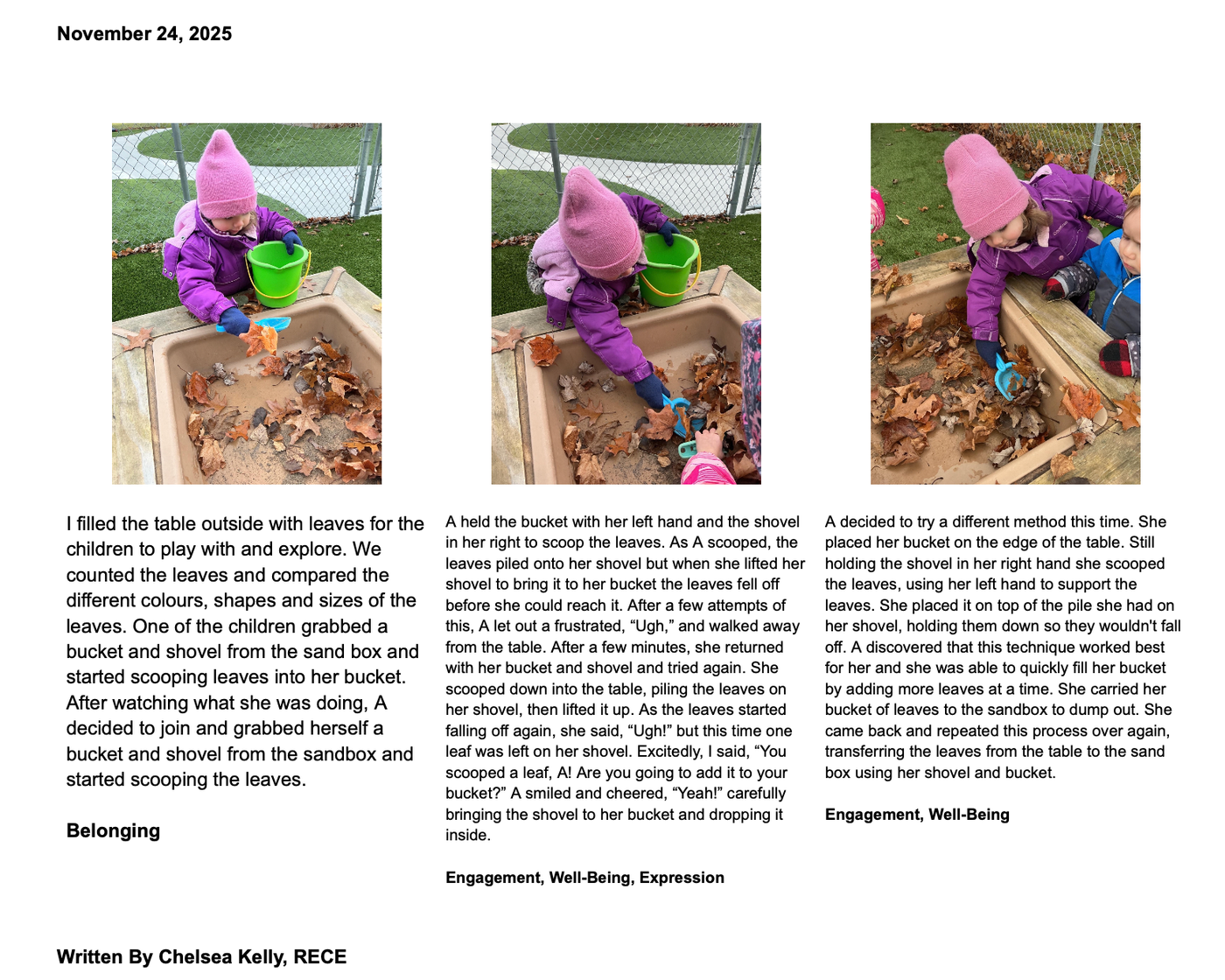
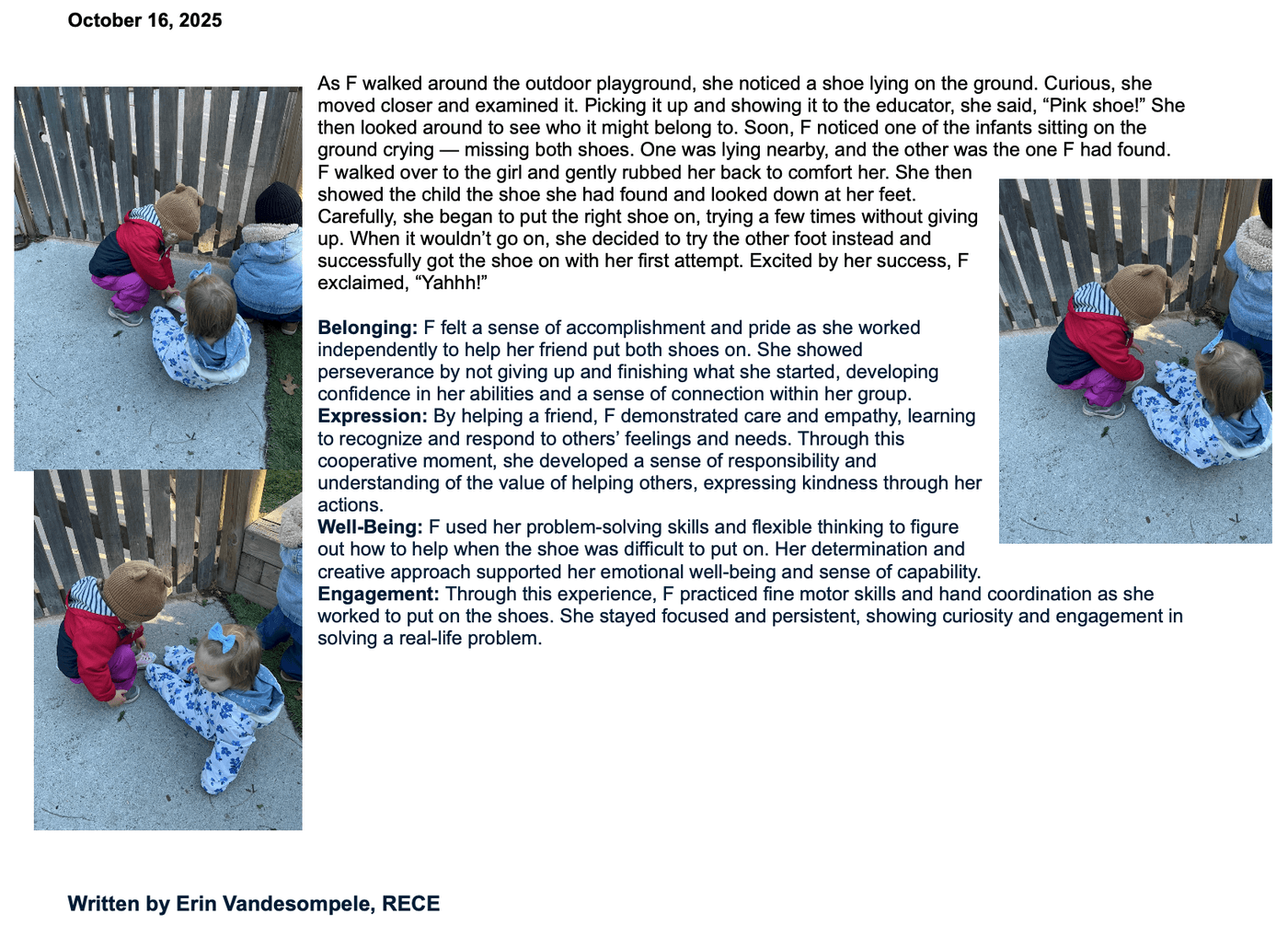
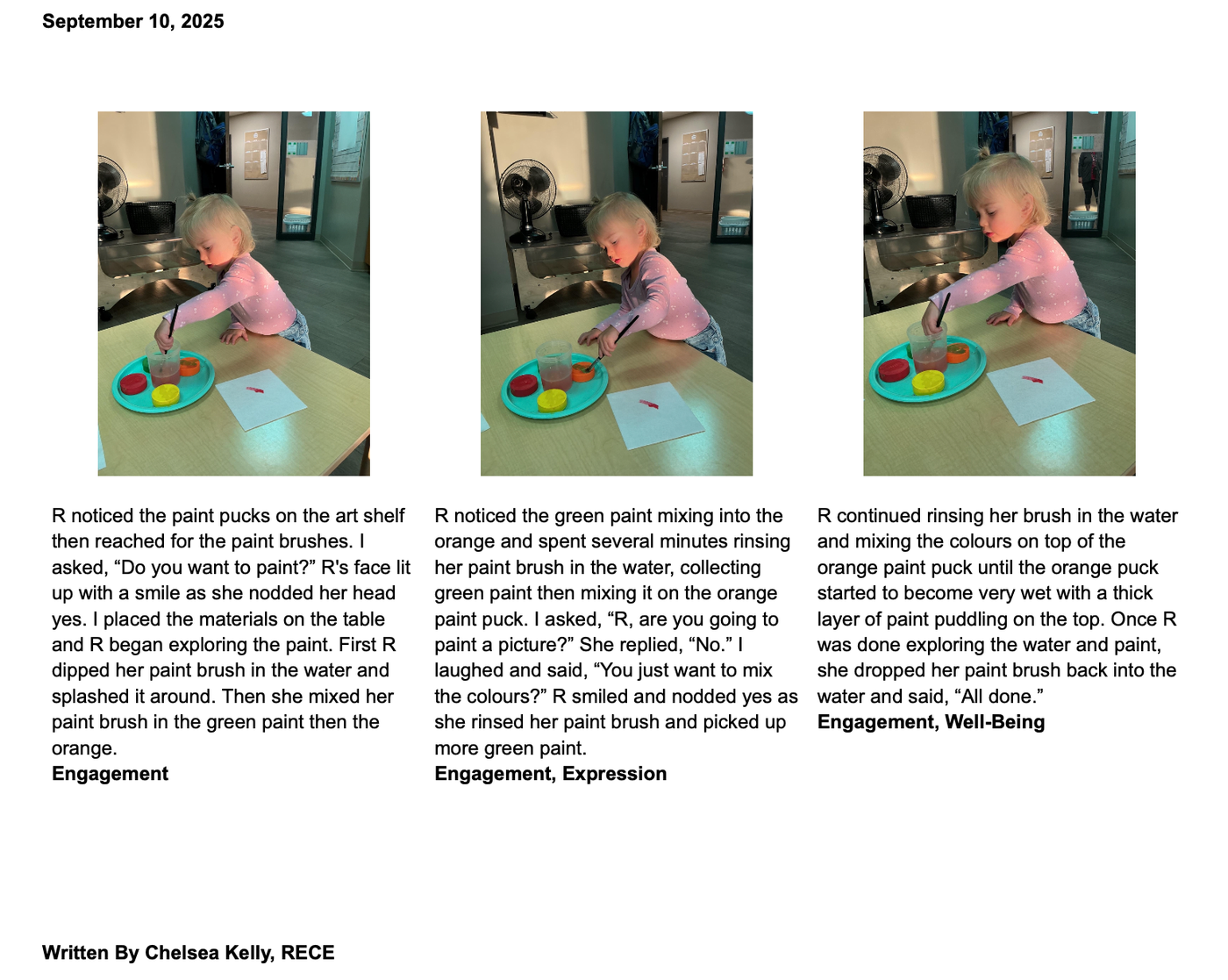
August 13, 2025
C studied the tower made out of pool noodles and spoons, looking carefully for just the right spot to place his pom pom. From the basket, he chose a blue pom pom, placing it gently on the larger spoon and slowly moving it over to the tower. After deciding the top was the perfect spot, he placed it there with care.
Returning to the basket, C picked up a red pom pom this time. Once again, he grasped the larger spoon, moved slowly and with intention, and placed it further down the tower. He continued this process, exploring different spots as he transferred pom poms from basket to tower.
Through this activity, C is developing a variety of skills including fine motor strength, hand-eye coordination, concentration, and even early math concepts such as spatial awareness and sorting. These seemingly simple transfers are building foundational skills for later learning in areas such as reading and writing.
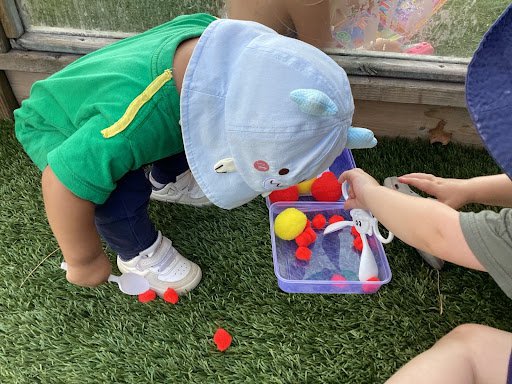
Engagement: C demonstrated focus and persistence as he carefully transferred each pom pom. Using spoons and tongs supported the development of the small muscles in his hands and fingers, essential for writing and self-help skills.
Well-Being: This activity highlighted C’s ability to concentrate and show patience. Successfully completing each transfer boosted his confidence and helped him strengthen his sense of accomplishment.
Expression: C expressed his abilities through his actions, showing coordination, confidence, and pride in his growing skills. His peers and educators could see his competence and determination.
Belonging: By taking part in this group activity, C demonstrated his willingness to participate, take turns, and connect socially with others, building positive relationships with both peers and educators.
By Erin Vandesompele, RECE
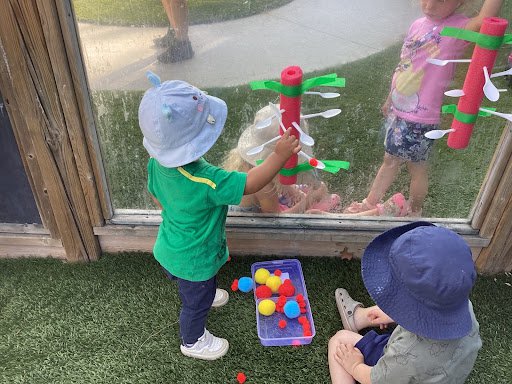
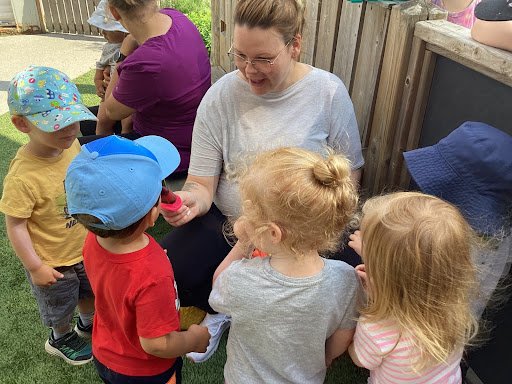
July 3, 2025
As I pulled down four frozen infused popsicle containers that were attached to each other, the children slowly started to gather to see what I had carried. J followed the descent of the popsicles coming down into my lap. Using her right index finger and making eye contact with me, she said, “what’s that?” Answering her question, I said, “these are popsicles but each one smells different. Do you want to smell them?” Nodding her head, her lips tilted up into a smile to answer my question. Wrapping my right hand around the handle of the first popsicle, I slowly pulled it out. Taking the frozen infused popsicle stick, I took a quick sniff to show the children what to do. Holding out the popsicle, each child slowly took a turn. When it reached J, she leaned in close to get her nose right above the frozen popsicle. Taking a large inhale through her nose, her nostrils flared as she sniffed the object. Her eyes narrowed down onto the frozen popsicle with her lips tilting downward. I said, “that’s italian seasoning, do you not like it?” Quickly, J shook her head back and forth in answer to my question. Using her right index finger, she pointed to the next infused popsicle that was red in colour. I said, “okay, let me get it out for you to smell.” Placing the italian seasoning back and pulling out the red coloured infused popsicle, we repeated the process of taking turns to smell the popsicle. When it was J’s turn, she leaned in closer to get a big sniff. Eyes widening, J licked her lips before trying to lick the infused popsicle stick. I said to her, “I know it smells good, it’s blood orange, but we can’t taste these.” Nodding her head, she said, “it does smell good. No licking,” as she began to giggle.
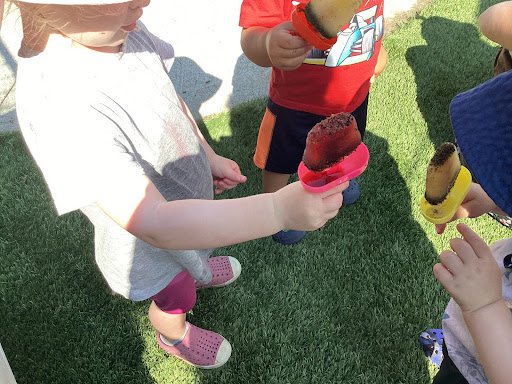
Belonging: J participated in a group with her peers, she was able to take turns smelling each infused popsicle stick.
Expression: Through body language, J expressed her pleasure in smelling the blood orange popsicle by licking her lips and trying to taste the infused popsicle stick. She showed her dislike for the Italian seasoned popsicle by narrowing her eyes and shaking her head “no” to liking that particular scent. J had been able to formulate questions by pointing and stringing two words together to further her knowledge.
Well-Being: When J’s eyes narrowed and her lips tilted downward, J chose to ask for a new infused popsicle stick to smell. She was able to remain calm and use her right index finger to point to the popsicle stick that she wanted to smell. When J attempted to lick the popsicle, J listened and made eye contact with the educator to show how she understood that the infused popsicle sticks were for smelling and not tasting.
Engagement: J was able to use two of her senses by seeing the color of each infused popsicle and smelling the infused popsicles. She was able to ask questions to further her understanding of what the infused popsicles were.
By Jessica Martin, RECE
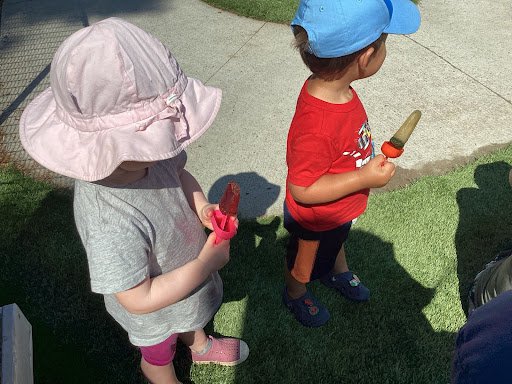
June, 2025
Finally the summer weather had arrived and the toddlers were enjoying themselves outside. A water provocation had been set up by the educators to help everyone stay cool. The bins in the mud kitchen had been filled with water. The children were all drawn to the colourful cups, bowls, scoops, and stir sticks. M walked up to her educator and asked, “Is it my turn?” “You can have a turn now,” her teacher replied. M selected some items to play with then asked her educator to pass her a green cup that was just out of reach. M then carefully used a metal scoop to try and fill the green cup. Only a few drops of water made it into the cup. “It didn’t work,” she told her educator. “Can you try something else?” her educator asked. M soon found a small, bright green bowl. She filled it and carefully poured it into the green cup. She smiled at her educator, proud of her success. M continued to play until a friend came along and asked M for a turn at the mud kitchen. M, as usual, was happy to share and went to play in the sand box.
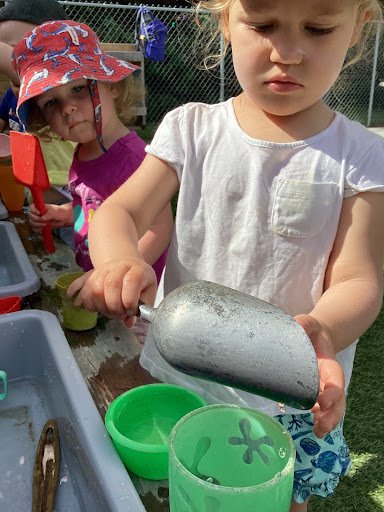
Belonging: During this water play M took part in conversation with her educator and a peer. She used this communication to problem solve and to have a smooth transition to the next activity.
Well-Being: M used her fine motor skills as she poured water into the green cup. When the scoop didn’t work, she showed her competency when she came up with a solution that worked great.
Engagement: It took focus for M to dump the water into the cup. She also tested the scoop first before realizing that it wouldn’t work.
Expression: M was able to effectively communicate with her friend and give them a turn. Her fine motor practice of careful pouring will help support M with writing in the future.
By Brianna Wall
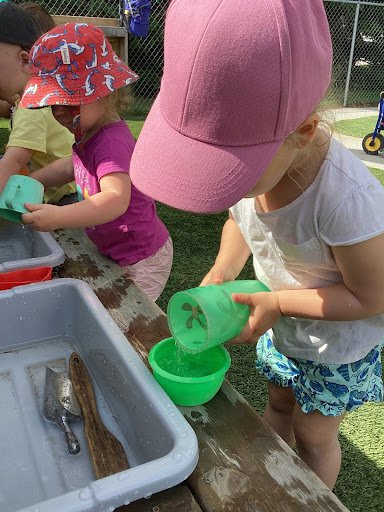
May 9, 2025
C approached the bins, analyzing the contents of each one. He first put his fingers in the bin filled with moss. Feeling the bumps and different features on the moss, he could feel the soil mixed with the crumbly and mushy feeling. He seemed unsure of what he was touching and did not care for it. He then moved onto the second bin filled with tulip flowers and petals. He enjoyed the smell as he brought the flowers up to his face, sniffing the flower. He turned to the educator, smiling as he showed her the flower, lifting the flower closer to her so she could also smell the flower. The educator turned to C, saying, “it smells so nice.” C agreed and smiled back, continuing on to find out what would happen as he started to pull the petals of the flowers, dropping them off into the bin. He moved on the third sensory bin where he reached in to feel the mixture of leaves and long grass. He put a small amount in his hands then folded his hand up, rolling the contents in his palm up into a ball where he could squeeze the leaves. He could hear the cracking and the crunching of the leaves.
Expression: C is expressing himself through visual sensory and touch as he explores different textured materials in each bin.
Engagement: As C participated in the activity, he was using hand eye coordination as he manipulated objects within the bins. He was able to observe and discover the different parts of the tulip flower as he picked the petals off, and he could see the different layers that make up the moss. He used his hands to roll the leaves and grass into a ball.
Well Being: C is using his tactile and visual discrimination to sort the objects by shape, colours, and textures, using logical thinking. Through the experience, fine motor and cognitive development was promoted. C used his senses to differentiate between various textures such as the smooth flowers, crunchy leaves and bumpy moss, as well as exploring different scents and sounds produced by the materials.
Belonging: Sensory play helps C regulate his feelings and emotions. He is interacting with the educator as he shares his experience with her as they take turns smelling the flowers, encouraging social interaction and parallel play.
Written By Erin Vandesompele, RECE
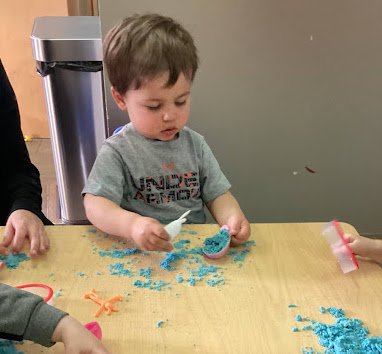
April 15, 2025
Today In our class we made kinetic sand that smelled like lavender and peppermint. M was one of the most excited to begin playing with the sand and start making things out of it. He showed so much joy when an educator said, “would you like to play with some kinetic sand?” He smiled with the biggest smile and began to laugh from how much he was ready to play. Once he sat at the table and received a kinetic sand ball he did not waste anytime. The first thing M did was he balled up his fist and smashed the kinetic sand and laughed. After smashing the ball it looked like M had a really good idea. He got out of his chair and walked over to the bin full of easter eggs and grabbed one that was already in half and showed an educator, saying, “look!” An educator said, “yes, that's a half of an easter egg.” M smiled and walked back to his chair and began to fill the egg up with the kinetic sand. He looked so focused and was in the zone. He was determined to make the egg shape with the sand. Once he accomplished filling the egg, he tipped it over and tried to pop it out. Once he realized that it was not all going to come out, he laughed and tried again and the second time the egg shape came out and looked perfect. He smiled and was so proud of what he did and then he smashed the egg and laughed with his fellow peers.
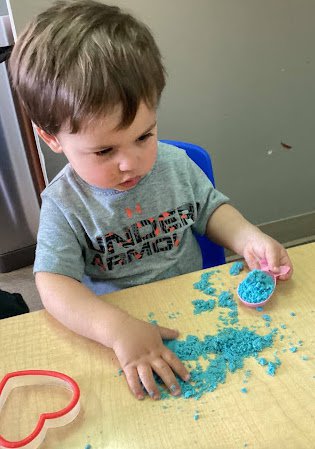
Belonging: M showed that he belonged by playing with his fellow peers, bonding over the same materials. M sought the predictable responses of his peers when they laughed as he smashed the kinetic sand, showing social interest.
Well-Being: He used his sensory motor integration while playing with the kinetic sand. He used scooping motions to fill the egg shape before tipping it to make a full egg shape.
Engagement: He played with the kinetic sand alongside his fellow classmates, engaging in parallel play. He played with the sand in his own way, not paying attention to what everyone else was doing, and decided to create an egg shape with it.
Expression: M showed that he was so excited and happy by smiling and laughing. He got his educator’s attention by saying, “look!” He also showed that he was having fun by using his fist and smashing the sand.
By Zeke Richardson
March 11, 2025
R approached the table where he found a muffin tin filled with cotton balls and some chopsticks. R was ready to investigate the materials. R picked up the chopsticks and looked them over, taking in their shape and appearance. He lifted them up in the air to show the educator as he was trying to grasp the chopsticks to see how to hold them to use them. The educator then demonstrated to R how to use them. After observing the educator, he had a better understanding of how to use the chopsticks. He decided it was time to try and attempt it himself. He adjusted his fingers to fit and he got more comfortable, finding his own way to independently use the chopsticks. He decided to focus his attention on a cotton ball that was in the middle of the muffin tin. As he got closer, the chopsticks touched the cotton ball. R grasped the cotton ball with the chopsticks and slowly directed the cotton ball towards him. The cotton ball stayed firmly in place with the chopsticks and did not fall. R became so excited that he completed his mission! He turned to the educator with a smile and said, “I did it! Yeah!” The educator congratulated him and smiled back at him, responding, “Great work, R!”
Engagement: R demonstrated movements using his fine motor skills by manipulating the chopsticks, strengthening his small hand muscles and improving his dexterity. R gained a sense of accomplishment and independence for his future skills. R explored containment by picking up cotton balls and transferring them over to different spots using spatial exploration.
Well-Being: R showed his abilities to manipulate the cotton balls with the chopsticks that require hand-eye coordination and fine motor muscle movements, helping to enhance his fine motor skills and using control when using the chopsticks.
Belonging: R looked to his educator for guidance to learn how to hold the chopsticks. When he completed his goal he was excited to share his achievement with his educator.
Expression: R expressed his feelings through verbal communication and actions when working together with educators using his words, saying “I did it! Yeah!” to the educator.
Written By Erin Vandesompele, RECE
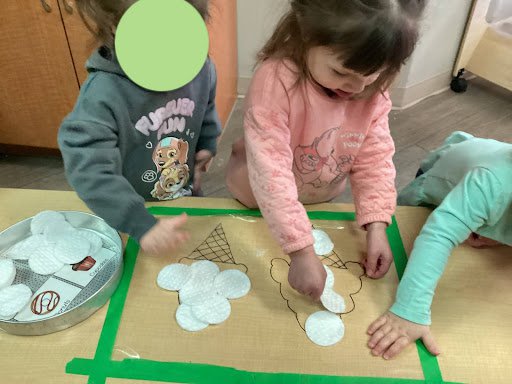
February 27, 2025
Spotting the two large ice cream outlines, L and a peer stepped up behind the canvas placed on the table. Placing her right hand onto the contact paper, the paper sealed to her hand. Leaning in close to investigate, her head tilted to the side to see that her hand was being pulled down. I said, “what happened to L?” L looked up at me and said, “it’s sticky.” Nodding my head, I said, “it is sticky, we are going to stick some fluffy cotton to fill in the ice cream then we can change the color of the ice cream afterwards.” Grabbing a container full of cotton, I handed the container to the children. At first, L used her thumb and forefinger to pick up the cotton pads and gently place it into the center of the outline. Seeing where she placed the cotton pads, L’s lips turned down into a frown before reaching for cotton pads that she recently applied. Using her right hand, she turned her thumb and her fingers into a claw-like position and pulled the cotton pad up from the outline. On further inspection, L looked closer to the tiny pieces of fluff behind the cotton. Using her finger tips, she brushed up against the pieces of fluff. Looking back at the educator, she said “so soft.”
Belonging: Throughout the activity, L had been using her communication skills and body language to share her thoughts and experiences of what the contact paper feels like and how the cotton pad felt against her finger tips.
Engagement: L had engaged the educator by describing her experiences of the different textures. She focused her attention to detail about what the contact paper and cotton pads had felt against her skin.
Well Being: L had been able to use her fine motor skills with ease and confidence by picking up the cotton pads between her thumb and forefinger to using her pincer grasp to peel away the cotton pad from the contact paper.
Expression: L had been able to use describing words such as soft and sticky to help the educator understand her thought process.
Written By Jessica Martin, RECE
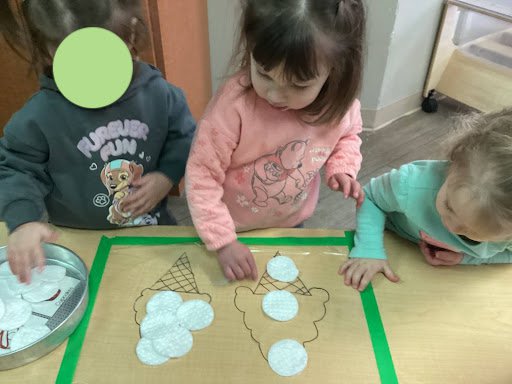
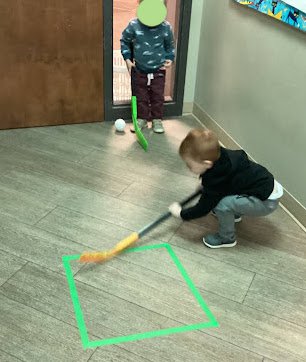
January 3, 2025
Placing two hockey sticks at the end of the classroom with a couple of fluffy snowballs, M and his peer came running over to snatch up the equipment. M used both hands to pick up the hockey sticks before handing one over to his peer. His peer took the hockey stick and backed into the corner of the room. M looked around the floor to find the fluffy snowball before using his entire palm to pick it up. Holding the snowball up in the air between him and his peer, he said, “ready, hockey.” Throwing the snowball onto the floor, he bent down with the hockey stick. He positioned his left arm further down the stick while his right arm was positioned up higher to balance the stick properly. Swinging the hockey stick up behind him, he moved his body with the momentum to hit the snowball. The snowball flew across the room into the corner, where his peer tried to follow where the snowball went. M patiently stood by, waiting for his peer to get the snowball with his hockey stick. When his peer was ready, M bent his knees and slapped his hockey stick to the ground to show that he was waiting.
Belonging: M showed his interest in wanting to participate by running over and picking up both hockey sticks. He was able to share the experience by giving his peer the other hockey stick to join in the activity.
Well Being: Throughout the activity, M proved to be physically active by bending his knees, using his entire body to move with the hockey stick and using his gross motor skills to hit the snowball. M had been able to use his eye-hand coordination to hit the snowball towards his peer.
Engagement: M had been able to participate in cooperative play with a peer by giving a turn to his peer when he was done hitting the snowball. He was able to share the experience with his peer by extending the extra hockey stick towards the other individual and using his communication skills to state what he wanted to do.
Expression: M had been able to show his interest in the hockey activity by getting into the proper position of bending his knees and slapping the stick onto the ground. He was able to verbally communicate, “ready, hockey,” to his peers.
Written By Jessica Martin, RECE
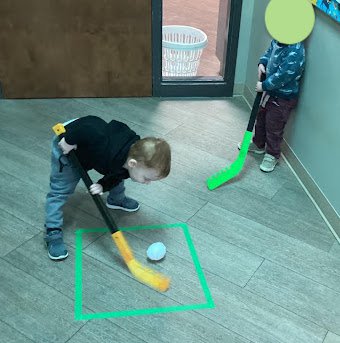
December 9, 2024
A toddler was walking towards the book area and she noticed that a friend was struggling to put her shoes on. She came closer to the peer and sat down beside her friend and said, “M help you.” Her friend turned and looked over to the toddler, smiling, and nodded at her. She first grabbed the other shoe sitting beside her friend and placed it in her hand, directing the shoe towards her friend's foot. She guided the shoe so her friend's foot would fit into the shoe, making sure it would go in properly. She turned to her friend and asked her, “it ok?” The friend smiled and once again nodded to her. The friend then passed M the other shoe to put on her opposite foot. M responded, “Push [friend].” The friend pushed but was unsuccessful. She then tried to guide her foot more into place and the friend was able to get into the shoe. Both girls then looked at each other and responded by clapping and saying, “Yeah!” The educator saw what M had done to help her friend and praised her by saying, “thank you for helping [Friend], that was a very nice. Good job.”
Belonging: As the toddler was helping her friend, she felt empathy and built on social skills that are important for building positive relationships with others around her. She saw her friend was struggling and she was there to help her.
Engagement: She used critical thinking to help figure out where her friend should put her foot in the right direction in order to get her foot into the shoe. She maintained focus and concentration as she helped her friend complete the task.
Well Being: As she was helping someone else, she was initiating her own learning experience by using problem solving skills to select the right shoe and using her motor skills to open the shoe before helping put on the shoe. She showed confidence by helping and having mastery over her own skills.
Expression: She expressed compassion as she was eager to help someone else. As she sat beside her friend, she let them know that she would help them and guided them using verbal directions. She and her friend celebrated their achievement with clapping and exclaiming, “Yeah!”
Written by Erin Vandesompele, RECE


